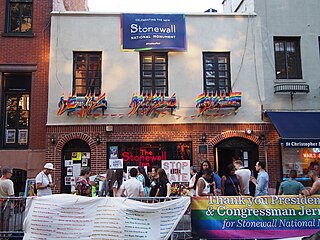Related Research Articles

Lesbian, gay, bisexual, and transgender (LGBT) movements are social movements that advocate for LGBT people in society. Although there is not a primary or an overarching central organization that represents all LGBT people and their interests, numerous LGBT rights organizations are active worldwide. The first organization to promote LGBT rights was the Scientific-Humanitarian Committee, founded in 1897 in Berlin.
Gay bashing is an attack, abuse, or assault committed against a person who is perceived by the aggressor to be gay, lesbian, bisexual, transgender or queer (LGBTQ+). It includes both violence against LGBT people and LGBT bullying. The term covers violence against and bullying of people who are LGBT, as well as non-LGBT people whom the attacker perceives to be LGBT.

The homophile movement is a collective term for the main organisations and publications supporting and representing sexual minorities in the 1950s to 1960s around the world. The name comes from the term homophile, which was commonly used by these organisations. At least some of these organisations are considered to have been more cautious than both earlier and later LGBT organisations; in the U.S., the nationwide coalition of homophile groups disbanded after older members clashed with younger members who had become more radical after the Stonewall riots of 1969.
This is a list of notable events in the history of LGBT rights that took place in the year 1972.
This is a list of notable events in the history of LGBT rights that took place in the 20th century before 1949.

Founded in 1952, One Institute, is the oldest active LGBTQ+ organization in the United States, dedicated to telling LGBTQ+ history and stories through education, arts, and social justice programs. Since its inception, the organization has been headquartered in Los Angeles, California.
"Gay agenda" or "homosexual agenda" is a pejorative term used by sectors of the Christian religious right as a disparaging way to describe the advocacy of cultural acceptance and normalization of non-heterosexual sexual orientations and relationships. The term originated among social conservatives in the United States and has been adopted in nations with active anti-LGBT movements such as Hungary and Uganda.

ONE National Gay and Lesbian Archives at the University of Southern California Libraries is the oldest existing lesbian, gay, bisexual, and transgender (LGBT) organization in the United States and one of the largest repositories of LGBT materials in the world. Located in Los Angeles, California, ONE Archives has been a part of the University of Southern California Libraries since 2010. ONE Archives' collections contain over two million items including periodicals; books; film, video and audio recordings; photographs; artworks; ephemera, such as clothing, costumes, and buttons; organizational records; and personal papers. ONE Archives also operates a small gallery and museum space devoted to LGBT art and history in West Hollywood, California. Use of the collections is free during regular business hours.
William Dorr Lambert Legg, known as W. Dorr Legg, was an American landscape architect and one of the founders of the United States gay rights movement, then called the homophile movement.
The Society for Human Rights was an American gay-rights organization established in Chicago in 1924. Society founder Henry Gerber was inspired to create it by the work of German doctor Magnus Hirschfeld and the Scientific-Humanitarian Committee and by the organisation Bund für Menschenrecht by Friedrich Radszuweit and Karl Schulz in Berlin. It was the first recognized gay rights organization in the United States, having received a charter from the state of Illinois, and produced the first American publication for homosexuals, Friendship and Freedom. A few months after being chartered, the group ceased to exist in the wake of the arrest of several of the Society's members. Despite its short existence and small size, the Society has been recognized as a precursor to the modern gay liberation movement.

Homophobia encompasses a range of negative attitudes and feelings toward homosexuality or people who identify or are perceived as being lesbian, gay or bisexual. It has been defined as contempt, prejudice, aversion, hatred, or antipathy, may be based on irrational fear and may sometimes be attributed to religious beliefs.
This is a list of notable events in the history of LGBT rights that took place worldwide in the 1950s.

Lesbian, gay, bisexual, transgender (LGBT) people in Yemen face severe challenges not experienced by non-LGBT residents. Same-sex sexual activity is punishable by death; this law is applied to both men and women. Members of the LGBT community additionally face stigmatization and homophobic violence among the broader population.
This is a list of notable events in the history of LGBT rights that took place in the 1960s.
LGBT rights organizations are non-governmental civil rights, health, and community organizations that promote the civil and human rights and health of sexual minorities, and to improve the LGBT community.
Henry Gerber was an early homosexual rights activist in the United States. Inspired by the work of Germany's Magnus Hirschfeld and his Scientific-Humanitarian Committee and by the organisation Bund für Menschenrecht by Friedrich Radszuweit and Karl Schulz, Gerber founded the Society for Human Rights (SHR) in 1924, the nation's first known homosexual organization, and Friendship and Freedom, the first known American homosexual publication. SHR was short-lived, as police arrested several of its members shortly after it incorporated. Although embittered by his experiences, Gerber maintained contacts within the fledgling homophile movement of the 1950s and continued to agitate for the rights of homosexuals. Gerber has been repeatedly recognized for his contributions to the LGBT movement.
James "John" Finley Gruber was an American teacher and early LGBT rights activist.
The following is a timeline of lesbian, gay, bisexual, transgender and queer (LGBTQ) journalism history.

The following is a timeline of lesbian, gay, bisexual, and transgender (LGBT) history in the 20th century.
References
- ↑ Robert B. Marks Ridinger (4 February 2004). Speaking for our lives: historic speeches and rhetoric for gay and lesbian rights (1892-2000). Psychology Press. p. 866. ISBN 978-1-56023-175-2 . Retrieved 15 February 2012.
- 1 2 Norman G. Kester (1997). Liberating minds: the stories and professional lives of gay, lesbian, and bisexual librarians and their advocates. McFarland. p. 92. ISBN 978-0-7864-0363-9 . Retrieved 15 February 2012.
- 1 2 David E. Newton (27 October 2009). Gay and lesbian rights: a reference handbook. ABC-CLIO. p. 7. ISBN 978-1-59884-306-4 . Retrieved 15 February 2012.
- 1 2 Betsy Kuhn (1 January 2011). Gay Power!: The Stonewall Riots and the Gay Rights Movement, 1969. Twenty-First Century Books. p. 13. ISBN 978-0-7613-5768-1 . Retrieved 15 February 2012.
- 1 2 Peter M. Nardi (15 July 1999). Gay men's friendships: invincible communities . University of Chicago Press. p. 32. ISBN 978-0-226-56843-0 . Retrieved 15 February 2012.
- ↑ Sam Deaderick; Tamara Turner (May 1997). Gay resistance: the hidden history . Red Letter Press. pp. 31–32. ISBN 978-0-932323-03-3 . Retrieved 15 February 2012.
- 1 2 Tracy Baim (1 September 2008). Out and proud in Chicago: an overview of the city's gay community. Agate Publishing. p. 34. ISBN 978-1-57284-100-0 . Retrieved 15 February 2012.
- 1 2 JoAnne Myers (30 July 2009). The A to Z of the lesbian liberation movement: still the rage. Scarecrow Press. p. 8. ISBN 978-0-8108-6811-3 . Retrieved 15 February 2012.
- ↑ David E. Newton (22 December 2009). Sexual health: a reference handbook. ABC-CLIO. p. 113. ISBN 978-1-59884-366-8 . Retrieved 15 February 2012.
- ↑ James Thomas Sears (30 October 2006). Behind the mask of the Mattachine: the Hal Call chronicles and the early movement for homosexual emancipation. Psychology Press. p. 168. ISBN 978-1-56023-187-5 . Retrieved 15 February 2012.
- ↑ Robert Deam Tobin (24 May 2000). Warm brothers: queer theory and the age of Goethe. University of Pennsylvania Press. p. 201. ISBN 978-0-8122-3544-9 . Retrieved 15 February 2012.
- ↑ Jim Kepner (1998). Rough news, daring views: 1950s' pioneer gay press journalism. Psychology Press. p. 8. ISBN 978-0-7890-0140-5 . Retrieved 15 February 2012.
- ↑ Lisa Keen; Suzanne Beth Goldberg (23 May 2000). Strangers to the Law: Gay People on Trial. University of Michigan Press. p. 82. ISBN 978-0-472-08645-0 . Retrieved 15 February 2012.
- ↑ Chad C. Heap (15 May 2009). Slumming: sexual and racial encounters in American nightlife, 1885-1940. University of Chicago Press. p. 376. ISBN 978-0-226-32243-8 . Retrieved 15 February 2012.